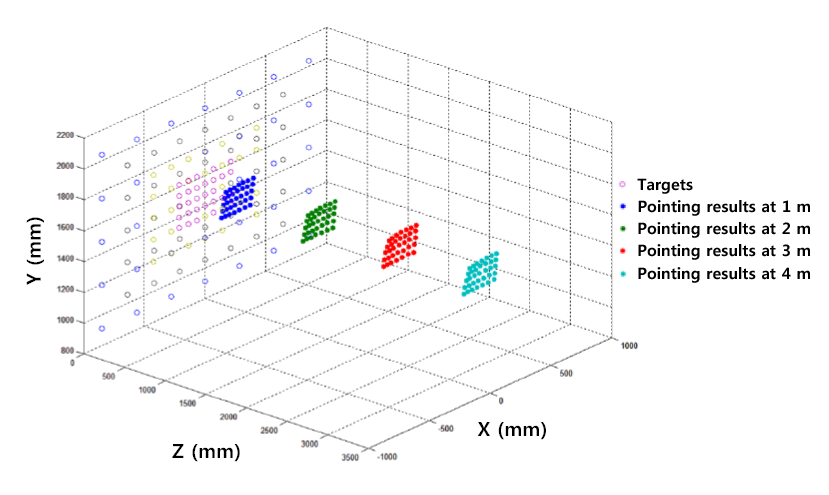Pointing & Selection
A Series of Research on 3D Interaction around Large Displays
(Interational Journal of Human-Computer Interaction)

Abstract
The use of large displays is becoming increasingly prevalent, but development of the usability of three-dimensional (3D) interaction with large displays is still in the early stage. One way to improve the usability of 3D interaction is to develop appropriate control–display (CD) gain function. Nevertheless, unlike in desktop environments, the effects of the relationship between control space and display space in 3D interaction have not been investigated. Moreover, 3D interaction with large displays is natural and intuitive similar to how we work in the physical world. Therefore, a CD gain function that considers human behavior might improve the usability of interaction with large displays. The first experiment was conducted to identify the characteristics of user’s natural hand motion and the user perception of target in distal pointing.
Thirty people participated and the characteristics of users’ natural hand movements and the 3D coordinates of their pointing positions were derived. These characteristics were considered in development of motion–display (MD) gain which is a new position-to-position CD mapping. Then, MD gain was experimentally verified by comparing it with Laser pointing, which is currently the best existing CD mapping technique; 30 people participated. MD gain was superior to the existing pointing technique in terms of both performance and subjective satisfaction. MD gain can also be personalized for further improvement.
This is an initial attempt to reflect natural human pointing gesture in distal pointing technique, and the developed technique (MD gain) was experimentally proved to be superior to the existing techniques. This achievement is worthy because even a marginal improvement in the performance of pointing task, which is a fundamental and frequent task, can have a large effect on users’ productivity. These results can be used as a resource to understand the characteristics of user’s natural hand movement, and MD gain can be directly applied to situations in which distal pointing is needed, such as interacting with smart TVs or with wall displays. Furthermore, the concept that maps natural human behavior in motor space and an object in visual space can be applied to any interactive system.
Publication
- International Journal of Human-Computer Interaction 35(2), 2019
Heejin Kim, Seungjae Oh, Sung H. Han, Min K. Chung.
Motion–Display Gain: A New Control–Display Mapping Reflecting Natural Human Pointing Gesture to Enhance Interaction with Large Displays at a Distance - ACM SUI WIP 2014 (Best Poster Award)
Heejin Kim, Seungjae Oh, Sung H. Han, and Min K. Chung.
Natural Pointing Posture in Distal Pointing tasks - ACM SUI WIP 2014
Seungjae Oh, Heejin Kim, and Hyo-Jeong So.
Proposing a Classification Model for Perceptual Target Selection on Large Displays - IEEE 3DUI POSTER 2014
Seungjae Oh, Heejin Kim, and Min K. Chung.
Understanding of Spatial Gestural Motor Space: a Study on Cursorless Absolute Freehand Pointing on Large Displays - Domestic Patent
Heejin Kim, Seungjae Oh, Sung H. Han, and Min K. Chung.
3D INTERACTION METHOD FOR DISPLAY
Application: 2016.9.30; Publication: 2018.4.4
Figure


Contribution
- Heejin Kim: Idea, Experiment, Experimental Design and Analysis, Writing, and Graphics
- Seungjae Oh: Ideation and Implementation (SW)
- Min K. Chung and Sung H. Han: Directors